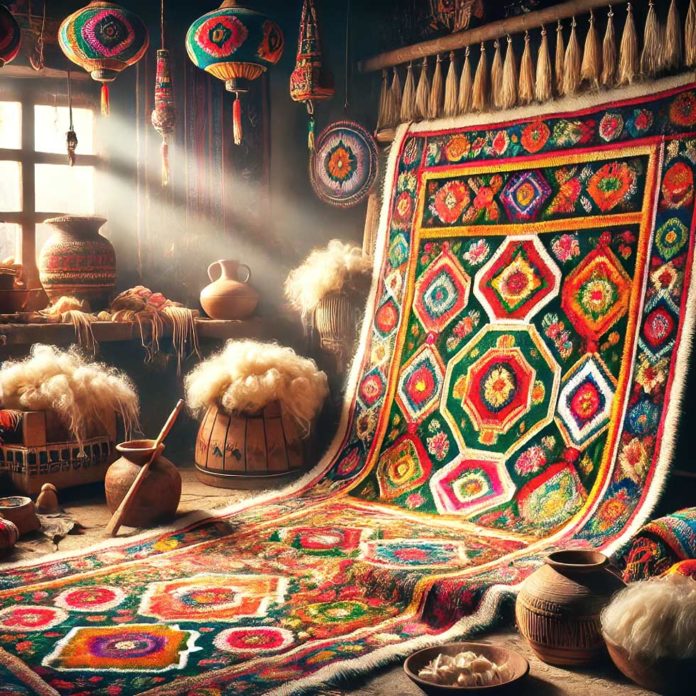Preserving History Through Felt Art
Bulgarian felt art, known as “plasti” (плъсти), is a captivating testament to Bulgaria’s rich cultural heritage. These intricate handcrafted woolen creations blend functionality with artistic expression, representing tradition and ingenuity.
A Historical Legacy
The origins of plasti trace back to ancient times. Archaeological evidence suggests that felting techniques appeared in Bulgaria as early as the Thracian period. This craft likely evolved from the nomadic traditions of Central Asia, spreading across Europe with trade and migration.
In Bulgaria, felt-making became a rural necessity. Wool was readily available, and felting transformed it into dense, durable textiles suitable for carpets, clothing, and insulation. Over time, the craft flourished, and artisans began embellishing their creations with colorful patterns, drawing inspiration from nature, folklore, and local traditions.
During the Ottoman era (14th–19th centuries), plasti served practical and symbolic purposes. Families adorned their homes with these textiles, using their vibrant designs to celebrate events, mark social status, and express regional identity. Patterns often featured geometric shapes, floral motifs, and mythical creatures, reflecting the cultural richness of different Bulgarian regions.
The Decline and Revival of Plasti
The advent of industrialization in the 19th and 20th centuries marked a decline in handmade crafts, including plasti. Mass-produced textiles replaced labor-intensive felts, and fewer artisans carried on the tradition. By the mid-20th century, the craft risked disappearing entirely.
However, efforts to preserve this cultural heritage gained momentum in the late 20th century. Ethnographers and cultural institutions documented traditional techniques, ensuring their survival. Local communities also embraced initiatives to revive the art, combining ancient methods with modern design sensibilities.
In recent years, plasti have experienced a renaissance. Artisans and designers have reintroduced them as decorative elements in contemporary homes, blending tradition with innovation. This resurgence highlights the enduring appeal of these handcrafted treasures.
A Showcase of Timeless Beauty: Current Exhibitions
The National Ethnographic Museum in Sofia hosts an exhibition dedicated to Bulgarian felt art. Running from November 15, 2023, to February 28, 2024, the exhibition explores the history, techniques, and cultural significance of plasti.
Visitors can admire rare antique pieces alongside modern interpretations, showcasing the evolution of this ancient craft. Highlights include richly colored felt rugs from Koprivshtitsa and intricately patterned designs from the Rhodope region. Interactive workshops allow visitors to try their hand at felting, offering a deeper connection to the craft.
Contemporary Applications and Cultural Impact
Today, plasti transcend their traditional roles. Designers incorporate felt art into fashion, interior design, and large-scale installations. This modern integration ensures the craft remains relevant while introducing it to global audiences.
In Koprivshtitsa, a town renowned for its vibrant cultural traditions, annual festivals celebrate felt-making. These events attract tourists and provide a platform for local artisans. Workshops teach participants to create their plasti, fostering a renewed appreciation for this timeless craft.
One remarkable example of modern felt art is the installation by Bulgarian artist Maria Zlatareva. Her felt-based works blend traditional patterns with abstract designs, earning international acclaim. This fusion of old and new exemplifies the dynamic potential of plasti in contemporary art.
Interesting Facts About Plasti
- The word “plasti” derives from the Bulgarian verb “plest,” meaning “to intertwine or layer”.
- Traditional felt rugs could take weeks to complete, depending on their size and complexity.
- Some patterns served as protective symbols, believed to ward off evil spirits.
- In Bulgarian folklore, felts were often associated with household harmony and prosperity.
Visit and Discover
If you’re in Sofia this winter, don’t miss the National Ethnographic Museum’s exhibition. Experience the vivid artistry of plasti and learn about the cultural narratives they embody. For a hands-on experience, attend one of the felting workshops and create your piece of Bulgarian heritage.
Bulgarian felt art is a bridge between the past and the present. Its resilience and adaptability reflect the enduring spirit of Bulgarian culture. Whether admired in a museum, used in modern interiors, or crafted by hand, plasti continue to inspire awe and appreciation.



